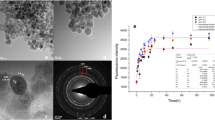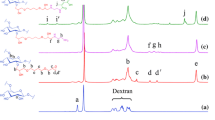Abstract
The clinical use of the anticancer drug doxorubicin (DOX) is limited by strong side effects and phenomena of cell resistance. Drug targeting by binding DOX to nanoparticles could overcome these limitations. We recently described a method to associate DOX to superparamagnetic iron oxide nanoparticles (SPION) in view of magnetic drug targeting (Munnier et al. in Int J Pharm 363:170–176, 2008). DOX is bound to the nanoparticle surface through a pre-formed DOX–Fe2+ complex. The DOX-loaded SPION present interesting properties in terms of drug loading and biological activity in vitro. The purpose of this study is to explore the possible mechanisms of the in vitro cytotoxicity of DOX-loaded SPION. The uptake of SPION was followed qualitatively by conventional optical microscopy after Prussian blue staining and quantitatively by iron determination by atomic absorption spectroscopy. The subcellular distribution of intrinsically fluorescent DOX was followed by confocal spectral imaging (CSI) and the subsequent cytotoxicity by the MTT method. We reveal modifications of DOX intracellular interactions for SPION-delivered drug and increased cytotoxicity. These results are discussed in terms of internalization route of the drug and of a potential role of iron oxide nanoparticles in the observed cytotoxicity.







Similar content being viewed by others
References
Alexiou C, Arnold W, Klein RJ, Parak FG, Hulin P, Bergemann C, Erhardt W, Wagenpfeil S, Lübbe AS (2000) Locoregional cancer treatment with magnetic drug targeting. Cancer Res 60:6641–6648
Anderson AB, Gergen J, Arriaga EA (2002) Detection of doxorubicin and metabolites in cell extracts and in single cells by capillary electrophoresis with laser-induced fluorescence detection. J Chromatogr B Anal Technol Biomed Life Sci 769:97–106
Apopa PL, Qian Y, Shao R, Lan Gua N, Schwegler-Berry N, Pacurari M, Porter D, Shi X, Vallyathan V, Castranova V, Flynn DC (2009) Iron oxide nanoparticles induce human microvascular endothelial cell permeability through reactive oxygen species production and microtubule remodelling. Part fibre toxicol 6:1–14
Aroui S, Brahim S, De Waard M, Bréard J, Kenani A (2009) Efficient induction of apoptosis dy doxorubicin coupled to cell-penetrating peptides compared to unconjugated doxorubicin in the human breast cancer cell line MDA-MB 231. Cancer Lett 285:28–38
Aroui S, Brahim S, Kenani A (2010) Cytotoxicity, intracellular distribution and uptake of doxorubicin and doxorubicin coupled to cell penetrating peptides in different cell lines: a comparative study. BBRC. doi:10.1016/j.bbrc.2009.11.073
Auffan M, Rose J, Wiesner MR, Bottero JY (2009) Chemical stability of metallic nanoparticles: a parameter controlling their potential cellular toxicity in vitro. Environ Pollut 157:1127–1133
Belhoussine R, Morjani H, Millot JM, Sharonov S, Manfait M (1998) Microspectrofluorometry reveals specific anthracycline accumulation in cytoplasmic organelles of multidrug-resistant cancer cells. J Histochem Cytochem 46:1369–1376
Choi SJ, Oh JM, Choy JH (2009) Toxicological effects of inorganic nanoparticles on human lung cancer A549 cells. J Inorg Biochem 103:463–471
Chourpa I, Douziech-Eyrolles L, Ngaboni Okassa L, Fouquenet JF, Cohen-Jonathan S, Soucé M, Marchais H, Dubois P (2005) Molecular composition of iron oxide nanoparticles, precursors for magnetic drug targeting, as characterized by confocal Raman microspectroscopy. Analyst 130:1395–1403
Conner SD, Schmid SL (2003) Regulated portals of entry into the cell. Nature 422:37–44
del Pozo-Rodríguez A, Pujals S, Delgado D, Solinís MA, Gascón AR, Giralt E, Pedraz JL (2009) A proline-rich peptide improves cell transfection of solid lipid nanoparticle-based non-viral vectors. J Control Release 133:52–59
Demaurex N, Grinstein S (2006) Measurements of endosomal pH in live cells by dual excitation fluorescence imaging. In: Cell Biol, 3rd edn. pp 163–169
Donaldson K, Stone V, Clouter A, Renwick L, MacNee W (2001) Ultrafine particles. Occup Environ Med 58:211–216
Douziech-Eyrolles L, Marchais H, Hervé K, Munnier E, Soucé M, Linassier C, Dubois P, Chourpa I (2007) Nanovectors for anticancer agents based on superparamagnetic iron oxide nanoparticles. Int J Nanomed 2(4):541–550
Ebbesen P, Pettersen EO, Gorr TA, Jobst G, Williams K, Kieninger J, Wenger RH, Pastorekova S, Dubois L, Lambin P, Wouters BG, Van Den Beucken T, Supuran CT, Poellinger L, Ratcliffe P, Kanopka A, Görlach A, Gasmann M, Harris AL, Maxwell P, Scozzafava A (2009) Taking advantage of tumor cell adaptations to hypoxia for developing new tumor markers and treatment strategies. J Enzyme Inhibit Med Chem 24(1):1–39
Ehrenberg MS, Friedman AE, Finkelstein JN, Oberdörster G, McGrath JL (2009) The influence of protein adsorption on nanoparticle association with cultured endothelial cells. Biomaterials 30:603–610
Engin K, Leeper DB, Cater JR, Thistlethwaite AJ, Tupchong L, McFarlane JD (1995) Extracellular pH distribution in human tumors. Int J Hypertherm 11:211–216
Fiallo MML, Garnier-Suillerot A, Matzanke B, Kozlowski H (1999) How Fe3+ binds anthracycline antitumour compounds. The myth and the reality of a chemical sphinx. J Inorg Biochem 75:105–115
Gabrielson NP, Pack DW (2009) Efficient polyethylenimine-mediated gene delivery proceeds via a caveolar pathway in HeLa cells. J Control Release 136:54–61
Gallois L, Fiallo M, Laigle A, Priebe W, Garnier-Suillerot A (1996) The overall partitioning of anthracyclines into phosphatidyl-containing model membranes depends neither on the drug charge nor the presence of anionic phospholipids. Eur J Biochem 241:879–887
Ge Y, Zhang Y, Xia J, He S, Nie F, Gu N (2009) Effect of surface charge and agglomerate degree of magnetic iron nanoparticles on KB cellular uptake in vitro. Colloid Surf B Biointerfaces 73:294–301
Glait C, Ravid D, Lee SW, Liscovitch M, Werner H (2006) Caveolin-1 controls BRCA1 gene expression and cellular localization in human breast cancer cells. FEBS Lett 580:5268–5274
Gumbleton M, Hollins AJ, Omidi Y, Campbell L, Taylor G (2003) Targeting caveolae for vesicular drug transport. J control release 87:139–151
Hande KR (2006) Topoisomerase II inhibitors. Update Cancer Therap 1:3–15
Hovorka O, St’astny M, Etrych T, Subr V, Strohalm J, Ulbrich K, Rihova B (2002) Differences in the intracellular fate of free and polymer-bound doxorubicin. J Control Release 80:101–117
Jain TK, Morales MA, Sahoo SK, Leslie-Pelecky DL, Labhasetwar V (2005) Iron oxide nanoparticles for sustained delivery of anticancer agents. Mol Pharm 2:194–205
Jing Y, Naladri M, Williams PS, Mayorga M, Penn MS, Chalmers JJ, Zborowski M (2008) Quantitative intracellular magnetic nanoparticles uptake measured by live cell magnetophoresis. FASEB J 22:4239–4247
Jones CF, Grainger DW (2009) In vitro assessments of nanomaterial toxicity. Adv Drug Deliv Rev 61:438–456
Karlsson HL, Cronholm P, Gustafsson J, Möller L (2008) Copper oxide nanoparticles are highly toxic: a comparison between metal oxide nanoparticles and carbon nanotubes. Chem Res Toxicol 21:1726–1732
Karukstis K, Thompson EHZ, Whiles JA, Rosenfeld RJ (1998) Deciphering the fluorescence signature of daunomycin and doxorubicin. Biophys Chem 73:249–263
Kataoka K, Matsumoto T, Yokoyama M, Okano T, Sakurai Y, Fukushima S, Okamoto K, Kwon GS (2000) Doxorubicin-loaded poly(ethylene glycol)-poly(beta-benzyl-L-aspartate) copolymer micelles: their pharmaceutical characteristics and biological significance. J Control Release 64:143–153
Leonard RCF, Williams S, Tulpule A, Levine AM, Oliveros S (2009) Improving the therapeutic index of anthracyclines chemotherapy: focus on liposomal doxorubicin (Myocet®). Breast 18:218–224
Lewinski N, Colvin V, Drezek R (2008) Cytotoxicity of nanoparticles. Small 4(1):26–49
Lübbe AS, Bergemann C, Riess H, Schriever F, Reichardt P, Possinger K, Matthias M, Dorken B, Herrmann F, Gurtler R, Hohenberger P, Haas N, Sohr R, Sander B, Lemke AJ, Ohlendorf D, Huhnt W, Huhn D (1996) Clinical experiences with magnetic drug targeting: a phase I study with 4′-epidoxorubicin in 14 patients with advanced solid tumors. Cancer Res 56:4686–4693
Mahmoudi M, Simchi A, Imani M, Shokrgozar MA, Milani AS, Häfeli UO, Troeve P (2009) A new approach for the in vitro identification of the cytotoxicity of Superparamagnetic iron oxide nanoparticles. Colloid Surf B Biointerfaces 75:300–309
Minotti G, Menna P, Salvatorelli E, Cairo G, Gianni L (2004) Anthracyclines: molecular advances and pharmacologic developments in antitumor activity and cardiotoxicity. Pharmacol Rev 56:185–229
Mosmann T (1983) Rapid colorimetric assay for cellular growth and survival: application to proliferation and cytotoxicity assays. J Immunol Methods 65:55–63
Mudhakir D, Akita H, Tan E, Harashima H (2008) A novel IRQ ligand-modified nano-carrier targeted to a unique pathway of caveolar endocytic pathway. J Control Release 125(2):164–173
Munnier E, Tewes F, Cohen-Jonathan S, Linassier C, Douziech-Eyrolles L, Marchais H, Soucé M, Hervé K, Dubois P, Chourpa I (2007) On the interaction of doxorubicin with oleate ions: fluorescence spectroscopy and liquid-liquid extraction study. Chem Pharm Bull 55:1006–1010
Munnier E, Cohen-Jonathan S, Linassier C, Douziech-Eyrolles L, Marchais H, Soucé M, Hervé K, Dubois P, Chourpa I (2008) Novel method of doxorubicin—SPION reversible association for magnetic drug targeting. Int J Pharm 363:170–176
Mykhaylyk O, Dudchenko N, Dudchenko A (2005) Doxorubicin magnetic conjugate targeting upon intravenous injection into mice: high gradient magnetic field inhibits the clearance of nanoparticles from the blood. J Magn Magn Mater 293:473–482
Pelkmans L, Helenius A (2003) Insider information: what viruses tell us about endocytosis. Curr Opin Cell Biol 15:414–422
Pradhan P, Giri J, Banerjee R, Bellare J, Bahadur D (2007) Cellular interactions of lauric acid and dextran-coated magnetite nanoparticles. J Magn Magn Mater 311:282–287
Pütz G, Schmah O, Eckes J, Hug MJ, Winkler K (2009) Controlled application and scheduled removal of nanoparticle based chemotherapeutics (CARL) will reduce dose limiting adverse events in anticancer chemotherapy. Med Hypothesis doi:10.1016/j.mehy.2008.11.027
Raghunand N, Mahoney BP, Gillies RJ (2003) Tumor acidity, ion trapping and chemotherapeutics. II. pH-dependent partition coefficients predict importance of ion trapping on pharmacokinetics of weakly basic chemotherapeutic agents. Biochem Pharmacol 66:1219–1229
Razzano G, Rizzo V, Vigevani A (1990) Determination of phenolic ionization constants of anthracyclines with modified substitution pattern of anthraquinone chromophore. IL Farmaco 45:215–222
Rudge SR, Kurtz TL, Vessely CR, Catterall LG, Williamson DL (2000) Preparation, characterization, and performance of magnetic iron-carbon composite microparticles for chemotherapy. Biomaterials 21:1411–1420
Schöpf B, Neuberger T, Schulze K, Petri A, Chastellain M, Hoffmann M, Hoffmann H, von Rechenberg B (2005) Methodology description of cellular uptake of PVA coated superparamagnetic iron oxide nanoparticles (SPION) in synovial cells of sheep. J Magn Magn Mater 293:411–418
Sharonov S, Chourpa I, Morjani H, Nabiev I, Manfait M, Feofanov A (1994) Confocal spectral imaging analysis in studies of the spatial distribution of antitumor drugs within living cancer cells. Anal Chim Acta 290:40–47
Shen Y, Tang H, Zhan Y, Van Kirk EA, Murdoch WJ (2009) Degradable poly(β-amino ester) nanoparticles for cancer cytoplasmic drug delivery. Nanomedicine doi:10.1016/j.nano.2008.09.003
Vibet S, Mahéo K, Goré J, Dubois P, Bougnoux P, Chourpa I (2007) Differential subcellular distribution of mitoxantrone in relation to chemosensitization in two human breast cancer cell lines. Drug Metab Disp 35:822–828
Vieseh O, Gunn J, Zhang M (2009) Design and fabrication of magnetic nanoparticles for targeted drug delivery and imaging. Adv drug deliv rev. doi:10.1016/j.addr.2009.11.002
Wilhelm C, Gazeau F (2008) Universal cell labelling with anionic magnetic nanoparticles. Biomaterials 29:3161–3174
Wilhelm C, Billotey C, Roger J, Pons JN, Bacri JC, Gazeau F (2003) Intracellular uptake of anionic superparamagnetic nanoparticles as a function of their surface coating. Biomaterials 24:1001–1011
Xiong XB, Ma Z, Lai R, Lavasanifar A (2010) The therapeutic response to multifunctional polymeric nano-conjugates in the targeted cellular and subcellular delivery of doxorubicin. Biomaterials 31:757–768
Zhang J, Misra RDK (2007) Magnetic drug-targeting carrier encapsulated with thermosensitive smart polymer: core-shell nanoparticles carrier and drug release response. Acta Biomater 3:838–850
Zhang Y, Yang M, Portney NG, Cui D, Budak G, Ozbay E, Ozkan M, Ozkan CS (2008) Zeta potential: a surface electrical characteristic to probe the interaction of nanoparticles with normal and cancer human breast epithelial cells. Biomed Microdevices 10:321–328
Zhang X, Meng L, Lu Q, Fei Z, Dyson P (2009) Targeted and controlled release of doxorubicin to cancer cells using modified single wall carbon nanotubes. Biomaterials 30:6041–6047
Acknowledgments
This study was supported in part by grants from the Ligue Nationale contre le Cancer (Comités Indre-et-Loire, Loir-et-Cher, Indre), France and from the Region Centre, France (NANOMAG Project).
Author information
Authors and Affiliations
Corresponding author
Rights and permissions
About this article
Cite this article
Munnier, E., Cohen-Jonathan, S., Hervé, K. et al. Doxorubicin delivered to MCF-7 cancer cells by superparamagnetic iron oxide nanoparticles: effects on subcellular distribution and cytotoxicity. J Nanopart Res 13, 959–971 (2011). https://doi.org/10.1007/s11051-010-0093-1
Received:
Accepted:
Published:
Issue Date:
DOI: https://doi.org/10.1007/s11051-010-0093-1




